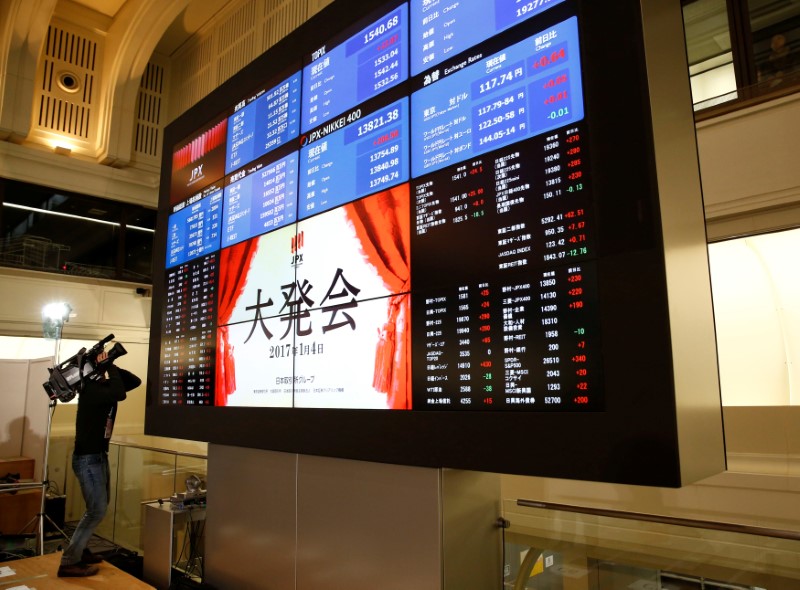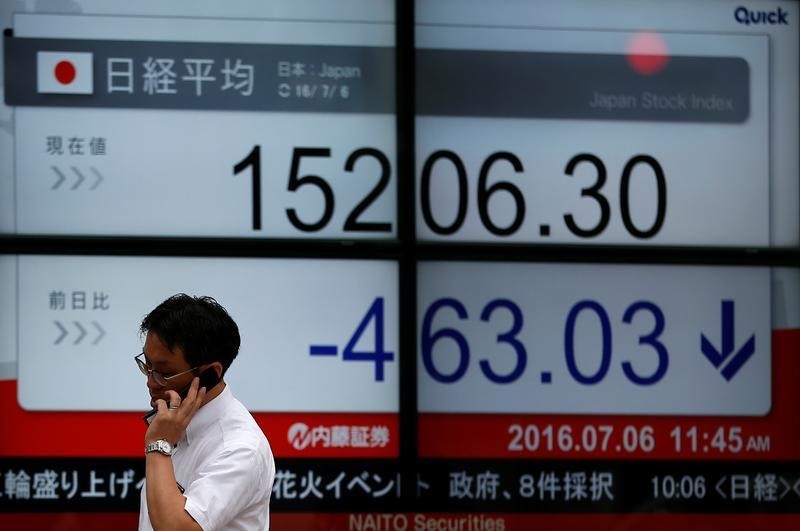By Jamie McGeever
LONDON (Reuters) - Investors took heart from upbeat economic data and growing signs that inflation on both sides of the Atlantic is gradually accelerating, fuelling a second day of 2017 gains across world stock markets on Wednesday.
Optimism over economic growth turned investors towards riskier assets that benefit from higher interest rates - such as equities - and away from lower-yielding assets, including bonds.
The euro moved further above $1.04 after data showed French consumer confidence hit its highest for nine years and businesses across the euro zone ended 2016 by ramping up activity at the fastest pace for five-and-a-half years.
This followed similarly upbeat reports this week on U.S., UK, Chinese and Japanese business activity.
Oil, commodity prices and bond yields ticked higher too, while the dollar slipped from a 14-year peak hit on Tuesday as the euro recovered some stability.
Investors will now turn their attention to the flash estimate for December's euro zone inflation figures and minutes of the Federal Reserve's policy meeting last month when it raised rates.
"What is important is the Fed's view on inflation, especially after the (strong) ISM manufacturing survey data yesterday," Avatrade trader Naeem Aslam said.
"Improvement in input prices is going to have an impact on final products which would, in turn, move the scale on inflation, upon which the Fed can no longer be reticent," he said.
Europe's index of leading 300 shares edged up 0.1 percent (FTEU3), supported by a 1-percent rise in financials (SX7P) and a 0.4-percent rise in basic resources stocks (SXPP). The index hit a 1-year high on Tuesday.
One of the biggest movers on major European bourses was UK retailer Next (L:NXT). Its shares fell as much as 14 percent after a profit warning. The stock has lost nearly 40 percent over the past year.
MSCI's benchmark global index rose for a second day to trade 0.3 percent higher (MIWD00000PUS), and its index of major Asian shares excluding Japan rose for a seventh consecutive day, gaining 0.3 percent (MIAPJ0000PUS).
U.S. futures pointed to a higher opening of between 0.1 percent and 0.2 percent on Wall Street (ESc1), priming the Dow Jones for another test of the 20,000-point mark (DJI).
DOLLAR INFLECTION POINT?
The potential for further U.S. rate hikes this year ensured profit-taking on the dollar's run on Tuesday was limited to just 0.15 percent against a basket of currencies (DXY).
The dollar's strength in Asian trading helped Japan's exporter-heavy stock market rally toward its biggest daily increase for almost two months.
In its first trading day of the year, the Nikkei (N225) climbed 2.50 percent and looked set for the highest close since December 2015. It was further aided by domestic data showing factory activity had expanded at the fastest pace in a year.
"For the dollar to push ahead from here, we'd need to see the Fed follow through on these anticipated hikes, but also for (president-elect Donald) Trump's bullishness on the economy to start to come to fruition," FXPro chief economist Simon Smith said.
The euro rose 0.3 percent to $1.0435
Euro zone inflation expectations are moving closer to the European Central Bank's target of just below 2 percent
ECB policymakers, who for years have struggled to lift growth and inflation, will also welcome the recovery in both the euro zone manufacturing and services sectors.
A rise in U.S. Treasury yields helped lift global bond yields but only marginally. The 10-year U.S. yield rose almost two basis points to 2.47 percent (US10YT=RR), but German and UK yields were flat at 0.26 percent (DE10YT=RR) and 1.32 percent (GB10YT=RR), respectively.
Germany's 10-year yield had hit a two-week high of 0.29 percent on Tuesday.
In commodity markets, oil prices recovered from a fall of more than 2 percent on Tuesday. U.S. crude (CLc1) bounced back 0.9 percent to stand at $52.77 a barrel, while Brent futures (LCOc1) rose 0.9 percent to $56.

Gold took advantage of the dollar's slip to trade 0.8 percent higher at $1,116 an ounce
